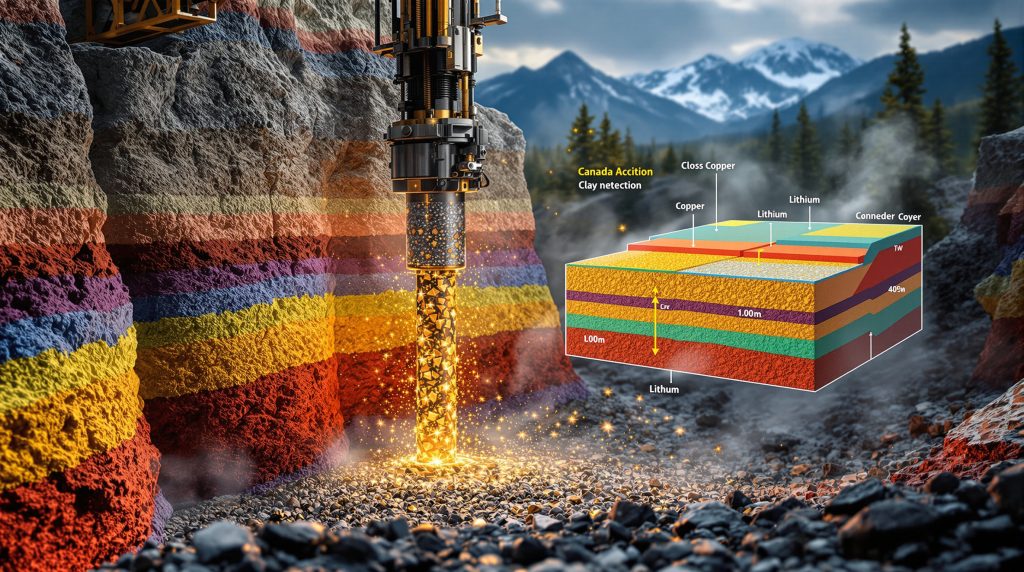What is Diamond Drilling and Why is it Essential for Canadian Mineral Exploration?
Diamond drilling stands as the backbone of Canada's mineral exploration industry, utilizing specialized diamond-impregnated bits to extract cylindrical rock cores from deep beneath the surface. This sophisticated technique provides geologists with intact samples that reveal crucial subsurface information impossible to obtain through other methods. As Canada maintains its position among global mineral exploration importance, with approximately 14% of global exploration budgets (about $1.9 billion CAD in 2023), diamond drilling functions as the definitive "truth machine" guiding investment decisions across the country's vast geological landscape.
In 2022 alone, exploration companies conducted approximately 8.5 million meters of diamond drilling across Canada, demonstrating the technique's central role in resource development. The extracted cores preserve exact geological features, mineralization patterns, and structural characteristics of underground deposits, creating physical records of subsurface conditions that enable evidence-based assessment of mineral potential.
How Diamond Drilling Works in Canadian Mineral Exploration
Diamond drilling employs industrial-grade diamonds embedded in drill bits to cut through even the hardest rock formations. These specialized bits contain synthetic or natural diamonds with particle sizes typically ranging from 20 to 60 mesh, embedded in metal matrices composed of tungsten carbide, bronze, or other materials designed for specific geological conditions.
The process creates cylindrical cores following standardized dimensions established by the International Organization for Standardization, including NQ (47.6mm), HQ (63.5mm), and PQ (85mm) diameter cores. These standards ensure consistency across the industry and compatibility with laboratory testing equipment, enhancing the reliability of analytical results.
What Makes Diamond Drilling the Gold Standard for Resource Assessment?
The unparalleled value of diamond drilling stems from its ability to extract intact core samples that preserve all geological features in their original state. Modern diamond drilling systems achieve core recovery rates exceeding 95% in competent rock formations, providing physical evidence that no other exploration method can match. Unlike reverse circulation or percussion drilling that produce fragmented chips or cuttings, diamond drilling delivers continuous cores that maintain structural integrity and stratigraphic relationships.
These cores undergo rigorous examination by expert geologists who document visual characteristics and prepare them for laboratory analysis, creating the foundation for resource assessment and development planning.
The Science Behind Core Sample Analysis
Core samples extracted through diamond drilling undergo meticulous examination by geologists who systematically log visual characteristics including:
- Rock types and geological formations
- Alteration patterns indicating mineralization processes
- Structural features such as faults, fractures, and veins
- Mineral assemblages and their spatial distribution
- Weathering profiles and geochemical signatures
This detailed logging creates comprehensive records that form the foundation for subsequent geological interpretation and modeling. In Canada, all publicly traded mining companies must comply with National Instrument 43-101 Standards of Disclosure for Mineral Projects, requiring qualified persons to oversee and certify diamond drilling programs and resulting resource estimates.
How Geochemical Analysis Transforms Raw Data into Valuable Insights
Core samples undergo sophisticated laboratory testing to determine:
- Precise concentrations of target minerals (gold, copper, nickel, lithium, etc.)
- Presence of pathfinder elements that indicate larger deposits
- Distribution patterns of valuable minerals throughout the deposit
- Metallurgical characteristics affecting processing requirements
- Potential contaminants or deleterious elements
Modern geochemical laboratories can detect gold concentrations as low as 0.001 parts per million using fire assay with ICP-MS finish, providing the precision needed for evaluating even low-grade deposits. Canadian industry best practice requires documented chain of custody for all core samples from drilling site to laboratory, including photographic core logging, sample interval marking, and secure transportation protocols.
How Does Diamond Drilling Drive Economic Viability in Mining Projects?
Diamond drilling represents the fundamental link between geological potential and financial investment in mining projects. The quality, quantity, and spatial distribution of drilling data directly determine confidence levels in resource estimates, which in turn drive investment decisions worth billions of dollars.
Resource Estimation and Classification Standards
Diamond drilling data forms the foundation for resource estimation according to internationally recognized standards. In Canada, the CIM Definition Standards (2014) establish specific requirements for resource classification:
| Classification | Drilling Density | Confidence Level | Investment Implication |
|---|---|---|---|
| Inferred | Wide-spaced (>100m) | Low-moderate | Early exploration potential |
| Indicated | Moderate spacing (50-100m) | Substantial | Preliminary economic assessment |
| Measured | Closely spaced (25-50m) | High | Bankable feasibility studies |
This classification system provides investors and mining companies with standardized confidence levels for making financial decisions. Resource estimation commonly employs geostatistical modeling techniques including kriging or inverse distance weighting algorithms, with block model cell sizes typically ranging from 5-25 meters depending on deposit geometry and drill spacing.
Financial Feasibility and Investment Decision Support
Diamond drilling provides critical data for:
- Calculating ore tonnage and grade estimates
- Determining stripping ratios for open-pit operations
- Planning underground development and infrastructure
- Estimating capital and operating costs
- Conducting net present value (NPV) and internal rate of return (IRR) analyses
According to the British Columbia Ministry of Energy, Mines and Low Carbon Innovation, diamond drilling costs in accessible areas range from $150-$300 per meter, while remote locations requiring helicopter support can exceed $500-$800 per meter. These costs represent significant investments, but they reduce the financial risk of subsequent development expenditures that may reach billions of dollars.
Osisko Mining's Windfall Gold Project in Quebec demonstrates the scale of drilling programs insights required for major resource development, with 762 diamond drill holes totaling approximately 408,000 meters resulting in an indicated resource of 4.0 million ounces of gold.
How is Diamond Drilling Revolutionizing Mineral Extraction in Canada?
Diamond drilling information directly shapes how minerals are extracted, creating safer, more efficient, and more profitable mining operations across Canada. By providing detailed insights into ground conditions, mineral distribution, and potential hazards, drilling data enables mining engineers to optimize extraction methods while minimizing environmental impact.
Optimizing Mine Design and Planning
Diamond drilling data directly influences critical mining decisions:
- Determining optimal pit dimensions and slopes for open-pit mines
- Planning underground development including tunnels, shafts, and stopes
- Designing ventilation systems and emergency escape routes
- Identifying areas requiring special ground support or water management
- Sequencing extraction to maximize economic returns
Core samples enable determination of rock mass rating (RMR) and Q-system classification, which directly inform ground support requirements including bolt spacing, mesh specifications, and shotcrete thickness in underground operations. Diamond drilling provides core for rock quality designation (RQD) measurements and laboratory testing including uniaxial compressive strength (UCS), typically ranging from 50-250 MPa in hard rock mining environments across Canadian Shield geology.
Enhancing Worker Safety Through Geological Hazard Identification
Core samples reveal potential safety hazards including:
- Unstable rock formations requiring additional support
- Water-bearing zones that could cause flooding
- Gas-bearing formations requiring ventilation planning
- Geotechnical weaknesses affecting ground stability
- Potentially reactive minerals that could cause equipment degradation
By identifying these hazards before mining begins, companies can implement appropriate safety measures to protect workers and prevent costly operational disruptions. This proactive approach has contributed to significant improvements in safety performance across Canada's mining sector.
What Technological Innovations are Transforming Canadian Diamond Drilling?
The diamond drilling sector in Canada has experienced remarkable technological advancement in recent years, dramatically improving efficiency, accuracy, and environmental performance. These innovations are transforming what was traditionally a labor-intensive process into a high-tech operation employing cutting-edge technologies.
Automation and AI-Driven Advancements
Recent technological developments revolutionizing diamond drilling include:
- Automated drilling systems requiring minimal human intervention
- AI-powered data processing algorithms for faster core analysis
- Smart sensors providing real-time drilling parameter optimization
- IoT-enabled equipment monitoring for predictive maintenance
- Remote operations centers managing multiple drilling sites
The global automated drilling market is projected to grow at a CAGR of 6.8% from 2023-2030, with Canada being an early adopter due to labor shortages and remote site challenges. Modern automated drilling systems incorporate mechanized rod handling that reduces manual labor by up to 70% and improves safety by eliminating manual lifting of drill rods weighing 30-60 kg each.
Advanced drilling systems now incorporate measurement-while-drilling (MWD) systems that record penetration rate, torque, thrust, and vibration data in real-time, creating digital footprints for each meter drilled. These AI-driven drilling advances improve efficiency while reducing operational costs and enhancing safety.
Enhanced Drill Bit Technology
Advancements in drill bit design significantly impact performance:
- Impregnated diamond bits with optimized cutting profiles
- Polycrystalline diamond composite (PDC) bits for specific formations
- Thermally stable diamond bits for high-temperature applications
- Custom matrix formulations for varying ground conditions
- Self-sharpening designs maintaining cutting efficiency longer
Thermally stable polycrystalline diamond (TSP) bits maintain cutting efficiency at temperatures up to 1,200°C, compared to 750°C for conventional diamond bits, essential for deep and geothermal drilling applications. These specialized bits extend tool life while improving penetration rates and core recovery, especially in challenging geological environments.
How Does Diamond Drilling Support Canada's Environmental and Sustainability Goals?
As environmental standards evolve, diamond drilling operations across Canada have implemented numerous innovations to minimize ecological impact while maintaining exploration effectiveness. These advancements reflect the industry's commitment to responsible resource development aligned with Canada's sustainability objectives.
Minimizing Environmental Footprint
Modern diamond drilling operations incorporate numerous sustainability measures:
- Closed-loop water recycling systems reducing freshwater consumption
- Biodegradable drilling fluids minimizing chemical impacts
- Portable drilling platforms requiring minimal site preparation
- Helicopter-transportable rigs accessing remote areas without roads
- Solar and hybrid power systems reducing fossil fuel dependence
Traditional diamond drilling operations can consume 100-200 liters of water per meter drilled, while modern closed-loop systems can reduce freshwater consumption by 80-90% through recycling. Modern biodegradable drilling polymers have replaced petroleum-based products in many Canadian operations, with degradation rates of 80-90% within 28 days under aerobic conditions.
Helicopter-portable drilling rigs commonly used in northern Canada weigh 2,000-4,000 kg and can be mobilized without requiring road construction, significantly reducing environmental disturbance compared to conventional tracked rigs requiring road access.
Waste Management Innovations
Advanced waste handling techniques include:
- Decanter centrifuges separating drill cuttings from fluids
- Solidification technologies for drill waste stabilization
- Bioremediation systems for organic contaminant breakdown
- Filtration systems capturing micro-particulates
- Engineered containment systems preventing environmental release
Contemporary drilling operations utilize engineered containment systems including geomembrane-lined sumps with minimum 40 mil HDPE liners and erosion control measures to prevent sediment release. All diamond drilling in Canada must comply with federal Fisheries Act and provincial environmental regulations, including requirements for sediment and erosion control plans when drilling within 30 meters of waterbodies.
What Role Does Diamond Drilling Play in Canada's Economic Future?
Diamond drilling forms the cornerstone of Canada's mineral exploration strategy, particularly as global demand increases for critical minerals essential to energy transition, technological advancement, and national security. The precise information provided by diamond drilling enables Canada to identify and develop resources that will shape its economic landscape for decades to come.
Supporting Critical Mineral Supply Chains
Diamond drilling is essential for identifying and developing deposits of:
- Battery metals (lithium, cobalt, nickel, graphite)
- Rare earth elements for high-tech applications
- Copper and other conductors for renewable energy infrastructure
- Strategic metals supporting national security interests
- Industrial minerals underpinning manufacturing sectors
Canada's Critical Minerals Strategy (2022) identifies 31 critical minerals including lithium, graphite, nickel, cobalt, and rare earth elements as priorities for exploration and development, with diamond drilling being the primary exploration method. Lithium exploration in Canadian pegmatites typically requires 10,000-30,000 meters of diamond drilling to define an initial resource, with drill spacing of 50-100 meters in pegmatite swarms.
These resources position Canada as a key supplier for global energy transition and technological advancement, with diamond drilling providing the fundamental data needed to develop secure domestic supply chains.
Driving Regional Economic Development
Diamond drilling programs create significant economic benefits:
- Direct employment opportunities for drilling crews and geologists
- Support for local businesses providing services to exploration companies
- Skills development and training for Indigenous communities
- Infrastructure improvements in remote regions
- Tax revenue generation supporting community services
The mineral exploration sector, heavily reliant on diamond drilling, directly employed approximately 14,000 Canadians in 2022, with indirect employment estimated at 2-3 times direct employment. Several diamond drilling companies in Canada are wholly or partially Indigenous-owned, providing employment and economic opportunities in remote communities.
These impacts extend far beyond the immediate mining sector, strengthening Canada's broader economy particularly in northern and rural regions where other economic opportunities may be limited.
How is Deep Diamond Drilling Unlocking New Mineral Frontiers?
As shallow mineral deposits become increasingly scarce, exploration companies are pushing technological boundaries to access resources at unprecedented depths. Advanced deep drilling capabilities are opening entirely new frontiers for Canadian mineral exploration, enabling the discovery of deposits that were previously beyond reach.
Exploring Previously Inaccessible Depths
Advancements in deep drilling capabilities are opening new exploration frontiers:
- Record-setting holes exceeding 3,000 meters in depth
- Specialized equipment handling extreme pressures and temperatures
- Directional drilling technologies accessing targets beneath sensitive areas
- Improved core recovery systems maintaining sample integrity at depth
- Enhanced navigation systems ensuring accurate target intersection
The deepest exploration diamond drill hole in Canada exceeded 3,400 meters at Osisko Mining's Windfall Gold Project in Quebec, requiring specialized equipment and procedures to manage extreme conditions. Rock temperatures in deep drilling can exceed 40-50°C at depths beyond 2,000 meters in Canadian Shield geology, requiring specialized cooling systems and thermally stable drilling equipment.
Modern directional drilling systems can achieve deviations of 70-80 degrees from vertical with downhole positioning accuracy of ±5 meters at 1,000-meter depths using advanced gyroscopic survey tools. These capabilities allow exploration of mineral systems previously considered inaccessible.
Case Studies: Record-Breaking Canadian Diamond Drilling Projects
Several notable projects showcase Canada's diamond drilling expertise:
- The 3,400+ meter exploration holes at Osisko Mining's Windfall project in Quebec
- Deep exploration beneath existing mines in Sudbury's nickel district
- Under-ice drilling programs in Canada's northern territories
- Complex directional drilling beneath environmentally sensitive areas
- Multi-year drilling campaigns defining world-class deposits
Vale's deep exploration programs beneath existing mines in the Sudbury Basin have utilized diamond drilling to depths exceeding 2,500 meters, discovering high-grade nickel-copper sulfide extensions. These achievements demonstrate Canada's leadership in advanced mineral exploration techniques and continue to expand the country's known resource base.
What Does the Future Hold for Diamond Drilling in Canadian Exploration?
Diamond drilling continues to evolve rapidly, with emerging technologies poised to revolutionize mineral exploration practices across Canada. These innovations promise to enhance efficiency, reduce environmental impact, and improve discovery rates as the industry adapts to changing global mineral demands.
Emerging Trends and Future Directions
The evolution of diamond drilling continues with:
- Integration of real-time geophysical measurements while drilling
- Advanced core scanning technologies providing immediate data
- Machine learning applications for drill targeting optimization
- Smaller environmental footprints through equipment miniaturization
- Enhanced mobility for rapid deployment in remote regions
Emerging technologies include automated hyperspectral imaging systems that can identify mineral assemblages and alteration patterns in drill core within minutes, compared to weeks for traditional logging and assaying. Hand-held X-ray fluorescence (XRF) analyzers enable real-time drilling results interpretation in the field, with detection limits of 1-10 ppm for many elements, accelerating exploration decision-making.
These developments will further improve exploration efficiency while reducing costs and environmental impacts, maintaining Canada's competitive position in global mineral exploration.
Meeting Growing Demand for Critical Minerals
As global demand for critical minerals accelerates, diamond drilling will play an increasingly vital role in:
- Expanding Canada's resource inventory of battery metals
- Defining new deposits of rare earth elements and technology metals
- Supporting domestic supply chains for strategic materials
- Enabling responsible development of resources in sensitive environments
- Maintaining Canada's position as a global mining leader
The global mineral exploration drilling market is expected to grow from $9.2 billion in 2023 to $12.8 billion by 2030, driven by demand for battery metals and critical minerals. This growth reflects the essential role diamond drilling plays in meeting the resource requirements of energy transition and technological advancement.
With its extensive geological expertise, regulatory framework, and technological capabilities, Canada is positioned to leverage diamond drilling as a cornerstone technology for defining and developing the resources needed for a sustainable future.
FAQ: Diamond Drilling in Canadian Mineral Exploration
What makes diamond drilling different from other exploration methods?
Diamond drilling extracts intact cylindrical core samples that preserve all geological features, providing physical evidence of subsurface conditions. Other methods like reverse circulation drilling or percussion drilling produce rock chips or cuttings that lose structural information and can be contaminated during collection. The continuous core samples from diamond drilling enable detailed geological interpretation impossible with fragmented materials.
How much does a typical diamond drilling program cost in Canada?
Diamond drilling costs in Canada typically range from $225-$600 per meter depending on location, depth, and ground conditions, according to S&P Global Market Intelligence (2024). A modest exploration program might include 5,000-10,000 meters of drilling, representing an investment of $1-5 million. Remote locations requiring helicopter support can see costs double or triple due to logistics challenges and fuel requirements.
How do Canadian diamond drilling practices compare globally?
Canada maintains some of the world's highest standards for diamond drilling operations, with stringent safety protocols, environmental regulations, and quality control measures. Canadian drilling contractors are recognized globally for their expertise, particularly in challenging environments like arctic conditions and deep drilling applications. The country's compliance with NI 43-101 standards also ensures transparency and reliability in reporting drilling results.
What training is required to work in diamond drilling in Canada?
Entry-level positions typically require safety certifications including first aid and WHMIS (Workplace Hazardous Materials Information System). The Mining Industry Human Resources Council (MiHR) provides standardized training frameworks for drilling personnel in Canada, including competency-based assessment programs. Provincial OH&S regulations vary but typically require basic occupational health and safety certification, WHMIS 2015 certification, first aid certification, and equipment-specific operation training.
How are Indigenous communities involved in diamond drilling projects?
Many exploration companies develop partnerships with Indigenous communities, providing employment opportunities, training programs, and business development through service contracts. Several diamond drilling contractors in Canada are wholly or partially Indigenous-owned, providing employment and economic opportunities in remote communities. These partnerships respect traditional knowledge while creating sustainable economic development in regions where other opportunities may be limited.
Ready to Catch the Next Major Mineral Discovery?
Stay ahead of the market with Discovery Alert's proprietary Discovery IQ model, which delivers real-time notifications on significant ASX mineral discoveries, turning complex geological data into actionable investment insights. Discover why historic mineral finds can generate substantial returns by exploring the dedicated discoveries page and begin your 30-day free trial today.




